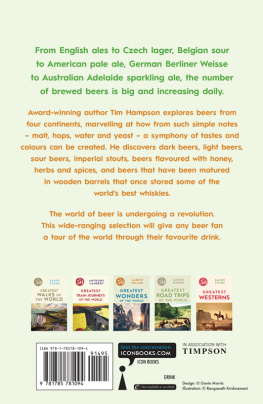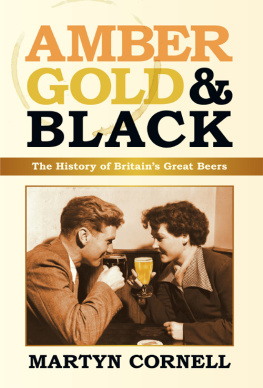
GREATEST
BEERS
OF THE WORLD

Also available
The 50 Greatest Road Trips
The 50 Greatest Westerns
The 50 Greatest Train Journeys of the World
The 50 Greatest Rugby Union Players of All Time
The 50 Most Influential Britons of the Last 100 Years
The 50 Greatest Walks of the World
Geoff Hursts Greats: Englands 1966 Hero Selects His Finest Ever Footballers
David Gowers Greatest Half-Century

GREATEST
BEERS
OF THE WORLD
TIM HAMPSON

Published in the UK in 2016 by
Icon Books Ltd, Omnibus Business Centre,
3941 North Road, London N7 9DP
email:
www.iconbooks.com
Sold in the UK, Europe and Asia
by Faber & Faber Ltd, Bloomsbury House,
7477 Great Russell Street,
London WC1B 3DA or their agents
Distributed in the UK, Europe and Asia
by Grantham Book Services, Trent Road,
Grantham NG31 7XQ
Distributed in Australia and New Zealand
by Allen & Unwin Pty Ltd,
PO Box 8500, 83 Alexander Street,
Crows Nest, NSW 2065
Distributed in South Africa by
Jonathan Ball, Office B4, The District,
41 Sir Lowry Road, Woodstock 7925
Distributed in India by Penguin Books India,
7th Floor, Infinity Tower C, DLF Cyber City,
Gurgaon 122002, Haryana
Distributed in Canada by Publishers Group Canada,
76 Stafford Street, Unit 300, Toronto, Ontario M6J 2S1
Distributed in the USA by Publishers Group West,
1700 Fourth Street, Berkeley, CA 94710
ISBN: 978-178578-109-4
Text copyright 2016 Tim Hampson
The author has asserted his moral rights.
No part of this book may be reproduced in any form, or by any means, without prior permission in writing from the publisher.
Images see individual pictures
Typeset and designed by Simmons Pugh
Printed and bound in the UK by Clays Ltd, St Ives plc
ABOUT THE AUTHOR
T im Hampson has travelled the world in search of the perfect beer, a quest he hopes will continue for many more years. His previous books include World Beer, The Beer Book, the Haynes Beer Manual, Londons Best Pubs, 101 Beer Days Out and Great Beers. He is the Chairman of the British Guild of Beer Writers, and in 2015 he was knighted by the Belgian Brewers Guild for services to beer culture. Tim lives in Oxford together with his family, three dogs and a parrot.
INTRODUCTION
T he 50 greatest beers in the world? The question is absurd. But within the embrace of the absurdity lies a gem of an idea.
Weve been drinking beers for more than 10,000 years. And for most of that time people just drank beer that was probably made at home or in a communal brewery. The evolution of beer styles and beer names is a relatively recent activity.
In recent times, for those of us who drink beer, it has often unerringly helped shape who we are. Many remember the first beer they drank as an underage youth. Others have fond recollections of sitting with a parent in a pub and drinking their first legal (or illegal) beer. For many, their university years are marked and remembered by the beers they drank. And years later, like some Proustian remembrance of days past, the memories will come back of the beers, the company and conversations. There are the great moments of time marked by the tastes and aromas of the beers people drank.
But 50 great beers? Some might argue such a list should be solely compiled from Britains rich tapestry of beers. But this narrow, jingoistic view of the beer world would exclude all the other countries where great beers are made and drunk. Beer culture is not limited to the United Kingdom and there are a number of internationally recognised beer brands and many countries have their own thriving brewing industry.
So will people from other countries find their favourite beers here? An Australian might expect to see VB, an Italian might look for Peroni Nastro Azzurro, some Belgians Jupiler or Stella Artois. Americans may ask where is the Budweiser or even the Miller Lite? A Brazilian might expect to find their beloved Brahma, perhaps someone from China will look for Snow. These beers are all well loved and well known, and they are sold by the bucketful. But volume doesnt make greatness and familiarity doesnt guarantee inclusion in this book.
Choosing the beers for this book has been no easy task. Britain alone has more than 1,500 breweries, the USA has 3,500, wine-loving Italy more than 700. On just about every continent from the Arctic down to the Antarctic, there are people brewing great beer. The number of beers being brewed is big and daily increasing.
So how to make it into my eclectic list of 50 great beers?
Ive travelled the world drinking beers and sat with many brewers discussing and analysing their creations, marvelling at how from such simple notes malt, hops, water and yeast a symphony of tastes and colours can be created. If there is a link between any of the beers in this book, it is that they in some way have made a contribution to evolving beer culture or are an exemplar of a particular beer style, or they are one of those beers that should be sought out by any beer fan just because they are so good to drink.
I imagine the first thing many people will do when they pick up this book will be to look at the contents list. They may be elated on finding a favourite beer. Many will be disappointed. But not being listed in this book doesnt make their favourite beer bad.
But a beers inclusion or exclusion could spark a conversation as to which are the greatest beers in the world. Beer brings people together; it is a liquid social lubricant that encourages us to talk and put the world to rights. And that is perhaps one definition of what makes a great beer everyone could agree about: the company of friends and conversation its what life is all about.
THE BREWING PROCESS
B rewing is a simple, natural process, normally just using water, cereal, hops and yeast. Fermentable sugars are extracted from a cereal using warm water, a process known as mashing. The liquid is then brought to boiling point and hops are added for flavour, bitterness and to ward off bacteria. It is then cooled, more hops might be added, yeast is added and the fermentation process begins converting the sugar into carbon dioxide and the alcohol we call beer.
1. MALTING
Before the grain gets to the brewery, it has to be malted. The process unlocks the complex sugars found in molecules of starch. To begin the process of releasing the sugars the maltster soaks the grains (steeps) and then gently heats them to begin the process of germination, creating simpler sugars. Inside the grain, as the seed starts to grow, the starch is broken down into simpler compounds. After a few days, the germination is stopped and the malt is dried and kilned. The more intense the kilning, the darker is the malt. The once hard grains are now soft enough to chew on and their sweetness can be tasted.
2. MILLING
In the brewery or at the maltsters, whole malted barley and other grains are ground in a mill. The cracked grain is known as grist and it is easier for it to release its sugars at the next stage when it is wetted, in warm water. The choice of grains made by the brewer is known as the grain bill and it is important because it will affect the amount of alcohol in the beer, its colour and its taste. Lighter coloured malts help make lagers pale. Dark roasted grains give stouts their blackness.
Next page















